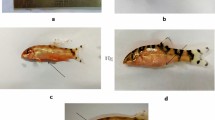Abstract
Modulation of innate immunity was determined in the Aeromonas hydrophila-challenged Asain sea bass, Lates calcarifer. The haemato-immunological parameters were studied in blood serum. Blood was sampled at 3, 6, 12, and 24th h post-challenged infection and control. Histopathological examination of most important organs (ventral musculature tissue, kidney and liver) was studied in the infected fish. The present study results indicated that at early stages of infection, TEC, Hb, PCV, MCV, MCH, and MCHC were not altered significantly, whereas in TLC, the values were fluctuated. Lysozyme, NBT, and protein were significantly increased (P < 0.05) at all the respective time periods than the control. Histopathological results of infected tissues revealed that the myofibrillar necrosis, congested blood vessels, large-sized melano-macrophage with hyper-cellular activity.

Similar content being viewed by others
References
Anderson DP, Siwicki AK (1995) Basic haematology and serology for fish health programs. In: Shariff M, Arthur JR, Subasinghe RP (eds) Diseases in Asian aquaculture II, Fish Health Section. Asian Fisheries Society, Manila, pp 185–202
Angka SL, Lam TJ, Sin YM (1995) Some virulence characteristics of Aeromonas hydrophila in walking catfish (Clarias gariepinus). Aquaculture 130(103):e12
Arias C, Welker TL, Shoemaker CA, Abernathy JW, Klesius PH (2004) Genetic fingerprinting of Flavobacterium columnare isolates from cultured fish. J Appl Microbiol 97:421–428
Bradford M (1976) A rapid and sensitive method for the quantification of microgram quantities of protein. Anal Biochem 72:248–254
Chen HQ, Lu CP (1991) Study on pathogen of bacterial hemorrhagic septicemia of rice eel. Chin J Zoon 7(e3):21
Dacie JV, Lewis SM (2001) Practical haematology, ninth edn. Churchill Livingstone, London
Das A, Sahoo PK, Mohanty BR, Jena JK (2011) Pathophysiology of experimental Aeromonas hydrophila infection in Puntius sarana: early changes in blood and aspects of the innate immune-related gene expression in survivors. Vet Immunol Immunopathol 142(3):207–218
Harikrishnan R, Moon YG, Kim MC, Kim JS, Heo MS (2010) Phytotherapy of Aeromonas hydrophila infected goldfish, Carassius auratus. J World Aqua Soc 41:391–401
Harikrishnan R, Nisha Rani M, Balasundaram C (2003) Hematological and biochemical parameters in common carp, Cyprinus carpio, following herbal treatment for Aeromonas hydrophila infection. Aquaculture 41e:221–250
Jena JK, Das PC, Kar S, Singh TK (2008) Olive barb, Puntius sarana (Hamilton) is a potential candidate species for introduction into the grow-out carp polyculture system. Aquaculture 280:154–157
Kandan S (2015) Culture of Sea bass (Lates calcarifer) in Cages in Ponds. In: Perumal S, A.R.T., Pachiappan P (eds) Advances in Marine and Brackishwater Aquaculture. Springer, New Delhi
Magnadottir B (2006) Innate immunity of fish (overview). Fish Shellfish Immunol 20(137):51
Medzhitov JR (2007) Recognition of microorganisms and activation of the immune response. Nature 449:819–826
Peyghan R, Khadjeh GH, Mozarmnia N, Dadar M (2010) Effect of intraperitoneal and intramuscular injection of killed Aeromonas hydrophila on lymphocytes and serum proteins of common carp, cyprinus carpio. Adv Biosci Biotechnol 1(01):26–29
Prusty AK, Kohli MPS, Sahu NP, Pal AK, Saharan N, Mohapatra S, Gupta SK (2011) Effect of short term exposure of fenvalerate on biochemical and haematological responses in Labeo rohita (Hamilton) fingerlings. Pestic Biochem Physiol 100:124–129
Reed LJ, Muench H (1938) A simple method of estimating fifty percent end points. Am J Hyg 27:493–497
Rice PA, Boehm GW, Moynihan JA, Bellinger DL, Stevens SY (2001) Chemical sympathectomy increases the innate immune response and decreases the specific immune response in the spleen to infection with Listeria monocytogenes. J Neuroimmunol 114(1):19–27
Saha H, Pal AK, Sahu NP, Saha RK (2016) Feeding pyridoxine prevents Saprolegnia parasitica infection in fish Labeo rohita. Fish & shellfish immunology 59:382–388
Sahoo PK, Mukherjee SC, Sahoo SK (1998) Aeromonas hydrophila versus Edwardsiella tarda: a pathoanatomical study in Clarias batrachus. J Aqua 6:57–66
Saurabh S, Sahoo PK (2008) Lysozyme: an important defence molecule of fish innate immune system. Aqua Res 39:223–239
Schaperclaus W (1991) Fish diseases, vol 1. Oxonian Press Pvt. Ltd, New Delhi
Sebastião FA, Nomura D, Sakabe R, Pilarski F (2011) Hematology and productive performance of nile tilapia (Oreochromis niloticus) naturally infected with Flavobacterium columnare. Braz J Microbiol 42(1):282–289
Tavares-Dias M (2000) Estudos parasitológicos e hematológicos empeixes oriundos de “pesque-pagues” do município de Franca, SãoPaulo. Jaboticabal, São Paulo, Brasil, 130p. (M.Sc. Dissertation. Centrode Aquicultura da Unesp).41
Ueda IK, Egami MI, Sasso WS, Matushima ER (1997) Estudos hematológicos em Oreochromis niloticus (Linnaeus, 1758) (Cichlidae, Teleostei)—Parte I. Braz J Vet Res Anim Sci 35(5):270–275
Wang CM, Lo LC, Zhu ZY, Lin G, Feng F, Li J, Orban L (2008) Estimating reproductive success of brooders and heritability of growth traits in Asian sea bass (Lates calcarifer) using microsatellites. Aquac Res 39(15):1612–1619
Acknowledgements
We would like to thank RGCA, Sirkali, India, for providing the fish source during the study.
Funding
The authors greatly acknowledge the Ministry of Earth Science (MoES), Government of India, for financial support for the project entitled “Prevalence and impact of ovarian parasitic nematode infestation on the economically important fishes of Tamil Nadu coast including cages and mariculture facilities” (MoES/36/OOIS/Extra/49/2016).
Author information
Authors and Affiliations
Corresponding author
Ethics declarations
Conflict of interest
The authors declare that they have no conflict of interest.
Ethical approval
In the present study, the Asian sea bass (L. calcarifer) used for experimental studies is widely consumed and cultured one in India. Previously, similar work has been carried out similarly. This article does not involve human samples or higher animals during the study.
Informed consent
This article does not have any studies with human participants.
Rights and permissions
About this article
Cite this article
Kathirkaman, P., Ayyaru, G., Serelathan, M. et al. Innate immunological responses of Asian sea bass, Lates calcarifer (Bloch, 1790) for experimentally challenged Aeromonas hydrophila infection. Comp Clin Pathol 27, 927–931 (2018). https://doi.org/10.1007/s00580-018-2683-8
Received:
Accepted:
Published:
Issue Date:
DOI: https://doi.org/10.1007/s00580-018-2683-8




